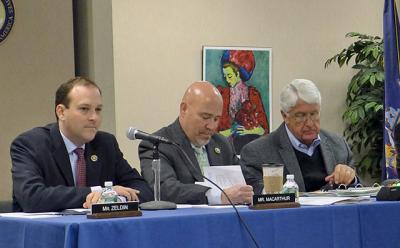The Varsity Dance Team in Limelight
The Varsity Dance Team in Limelight

The East Hampton High School dance club was founded in 2002, though this is the first year that its competition team members are to receive varsity letters.
Fittingly, that 16-member team, most of whom are seniors, took first place Sunday in the Long Island Kickline Association’s dance division at Uniondale High School, performing a lively two-and-a-half-minute routine to Queen’s “Another One Bites the Dust.”
The judges, according to Andrea Hernandez, who coaches the team with Katelyn Pryal, “loved the energy of the piece — they felt that the dance was a real crowd-pleaser . . . they commended the team’s energy, persistence, and sportsmanship, and were very impressed by their professionalism as it had to do with the choreography.”
“The seventh graders I started out with at the middle school are this year’s seniors,” Hernandez said during a conversation Friday at the high school, where she teaches Spanish. “We’ve got 30 in the club, beginners to advanced, which is nice because it enables the more advanced kids to serve as role models for the younger ones. . . . There are no divas.”
She and Pryal oversee practices “two or three times a week, and this past summer we had about five clinics as well. It’s the third year that we’ve taken part in the Uniondale competition. Last year, we were third in our division.”
Hernandez said, in answer to a question, that she had grown up in Manorville and had been a cheerleader at Eastport High School, which at the time didn’t have a dance club. She danced, she said, at a studio — as is the case with about half of East Hampton’s competition team’s members.
She and Pryal formed a good team, Hernandez said, inasmuch as “I have more experience with jazz and she’s got extensive kickline experience. Our goal is to expand our horizons — dance is just one of the competitive divisions, there’s kickline, hip-hop, and pom too.”
The club’s performance under the lights at homecoming took the edge off a 20-0 loss to Center Moriches, and it is to perform at the East Hampton-Bayport boys basketball game here this Saturday.
Hernandez describes dance as “a physical art,” a definition with which her charges, some of whom were interviewed following Saturday’s practice at the middle school, agree.
“Some think they’re not agile enough in the beginning,” she said, “they have doubts, but soon they find they can do what they thought they couldn’t do, which is exciting. There’s emotional development too. Jazz, for instance, may look dry at first, too technical, as if it has no heart, but they warm to it in time.”
The competitions were rigorous, Hernandez and Pryal, who joined in the conversation near its end, said, beginning with checks, much like those that referees conduct in other sports, for jewelry, et cetera.
“You get three minutes to get on and off, to show what you have, or points are deducted,” said Hernandez.
“You have to be totally in sync, every motion,” said Pryal. “How complex your routine is is factored into the scoring.”
“It’s a high risk, high reward kind of thing — we’re challenging them,” said Hernandez. “While it might be safer, for instance, to do one turn, two is worth more.”
The competition team comprises Jacqueline Bates, Lejdi Contreras, Julie Ehm, Amanda Fioriello, Karah Jones, Ally Karlin, Melissa Lopez, Sherie Samuels, Valentina Sanchez, Maggie Ryan, Daisy Vargas, Lauren Zaino, Angelica Zambrano, Claire Belhumeur, Jillian Hear, and Yean Franco, the sole male in the group.
Ryan and Hear study ballet, and Belhumeur was until recently a competitive figure skater.
Fioriello, Ehm, Samuels, and Franco, all of them captains, talked about the club and team after Saturday morning’s practice at the middle school.
“I would have played field hockey,” Fioriello said when they were asked what they would have done had there been no dance club at the high school, “but I love dance. I’ve been doing it since seventh grade.”
Ehm said it was “amazing” that it’s now considered a varsity sport. “We’ve got new uniforms, new leotards. . . .”
“No more hand-me-downs,” said Franco, who, as is the case with his fellow captains, is involved in the high school’s theater program.
“It’s nice that we’re getting more recognition,” said Ehm, who is a studio dancer as well.
“I don’t know what I would have done if there hadn’t been a dance club, probably nothing,” said Samuels.
Their coaches, the four said, worked just as hard as they. “They keep us going,” said Franco.
Samuels, when asked how they’d done at Uniondale in the past few years, said, “We were third, second, and third.”
Asked about the team aspect of their discipline, Fioriello said, “We’ve really been bonding.”
“We sweat and bleed together,” said Ehm, who added, when asked if she and the others would keep on dancing, “I can’t imagine a world without it.”






